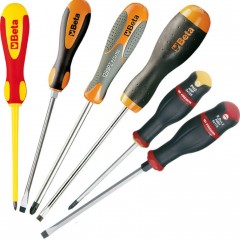How to use a stripper for wires?
Types of insulation strippers
Stripping pliers differ both in the principle of operation and constructively. There are manual, semi-automatic, automatic strippers. All of them are united by the principle of action, an incision of insulation and its removal from the conductor to a certain length.
Manual pullers have the simplest working mechanism. In appearance, the mechanical stripper is similar to pliers, only on the lips there are additional nests with blades for different sections of current-carrying conductors. This type of tool is suitable for stripping insulation from wires with a cross section of not more than 6 mm.sq., as well as for crimping lugs (some models allow). It is not difficult to work with a manual stripper - you just need to install the core in the socket, press the handles (grasping) and make a circular motion, as a result of which the insulating shell will be removed.
Semi-automatic puller models are even easier to operate. The mechanism is more advanced, so there is no need to independently scroll the stripper around the wire. It is enough just to fix the core in a suitable socket and press the handle. Also, many models of semi-automatic pullers allow you to cut wires and crimp lugs.
Automatic stripper is already a professional tool for stripping wire. Its difference from the semiautomatic device is an independent determination of the wire section, due to which the stripping process is reduced to the fact that you just need to install the core in the socket and press the handle. Automatic strippers are the most expensive, but also capable of simultaneously removing the protective sheath from several wires, stripping the insulation from the middle of the wire, stripping the sheath from flat conductors and much more.
Which stripper is better to choose
If we talk about small electrical work at home, it is better to choose a manual stripper for cutting the cable, which will allow you to clean the sheath from the cores, cross-section up to 6 mm.kv. Mechanical models are inexpensive, about 400, in addition, for home electricians, they will be quite suitable in functionality.
Electricians, whose life is directly related to the wiring, it is better to choose a semi-automatic or automatic stripper.The price of the tool starts at 1000, for a quality puller you have to pay even more. But if you take into account how much simplified and most importantly accelerated the wiring, you can without hesitation give preference to an improved mechanism.
Instrument Use Rules
Stripping lived
Consider the operating instructions for the example of the Chinese semi-automatic stripper, serving faithfully for more than one year. This model is absolutely not whimsical and easy to maintain.
The cutting element is a pair of plates with dimensional die-cutting for different core diameters, as shown in the photo:
Putting the wire in the grip of the pincers, leave the wire length for stripping the insulation, behind the knives, as shown in the photo below:
Holding the wire we reduce the pincers, squeezing the handles. The knives converge through the insulation, and the persistent jaws squeeze and pull the wire back. As a result, the insulation is removed from the wire.
The manual for the manual stripper is provided in the video:
An important point when using a stripper is to choose the right size for die cutting in knives, if you make a mistake with the diameter, the soft conductor will be damaged and may even break off at the place of stripping. Also, do not grab a large length of conductor insulation, it is better to divide it into several operations for less. With sufficient dexterity, stripping insulation with a stripper takes less than a second, and the work itself ceases to be boring and routine. Therefore, the acquisition of this device saves time and money, as well as the power of an electrician. In addition, the tool pays off with interest.
Ferrules
If you do not have at hand a crimper that is used to crimping wires with sleeves, you can crimp the stripper. To work with the tool in this case is quite simple. First, remove the insulation to the desired length, then install the tip on the core and insert it into the appropriate connector on the handle. Squeeze the handles and in the end you should get a crimped tip. The last stage - cut off the excess part of the core at the end, if necessary.
The video below clearly shows how to use an automatic stripper to cut the cable and crimp the tips:
So we examined what a stripper is for stripping wires. Now you know which version is best used for domestic needs and work, as well as how to use a puller to strip the cable and crimp the terminals.
It will be useful to read:













